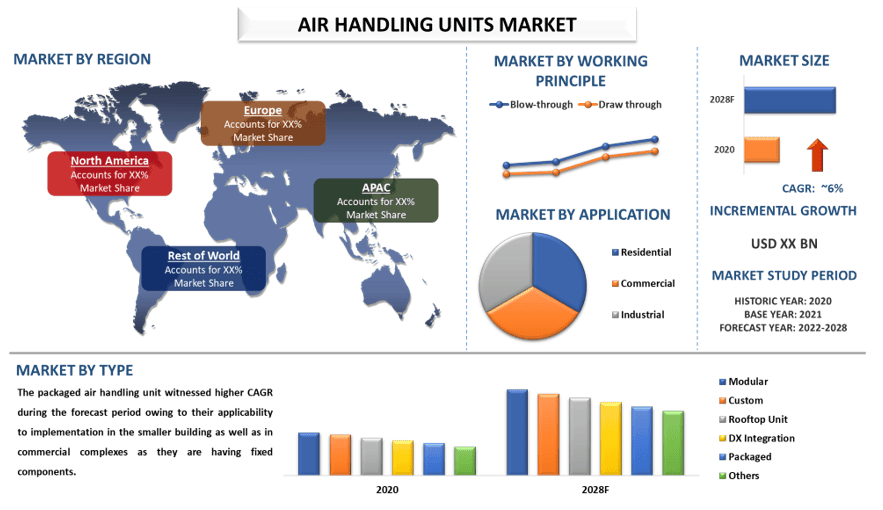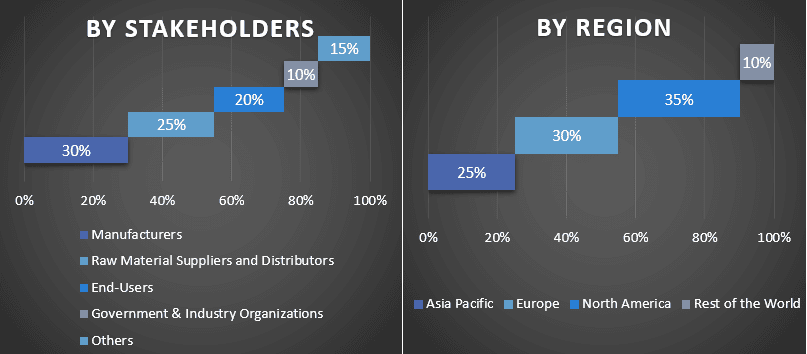Рынок установок для обработки воздуха: текущий анализ и прогноз (2022-2028 гг.)
Акцент на типе (модульные, индивидуальные, крышные установки с интеграцией DIX, комплектные и другие); принцип работы (с нагнетанием и всасыванием); применение (жилое, коммерческое и промышленное); и регион/страна

Ожидается, что глобальный рынок центральных кондиционеров будет расти значительными темпами, примерно на 6%, в течение прогнозируемого периода. Центральный кондиционер (AHU), также называемый воздухообрабатывающим агрегатом, представляет собой систему фильтрации воздуха, изготовленную из оцинкованной стали, алюминия и других сплавов, которые оснащены двухстенными панелями для обеспечения энергоэффективности и используются для контроля движения воздуха снаружи внутрь здания. Он забирает воздух снаружи, обрабатывает его, что включает в себя нагрев, увлажнение и охлаждение, и подает свежий воздух в здание или в отведенное пространство. Он может быть установлен как в жилых, так и в коммерческих зданиях. Центральный кондиционер состоит из вентилятора, фильтра, змеевика охлаждения, змеевика нагрева, системы нагнетателя, системы воздуховодов и системы двигателя. Он охлаждает помещения и подает свежий воздух внутрь, нагревая или охлаждая их в соответствии с температурой воздуха внутри. Кроме того, работа центральных кондиционеров включает в себя циркуляцию, нагрев, увлажнение, охлаждение, очистку, осушение и смешивание воздуха. Более того, увеличение инвестиций, слияния и поглощения, а также технологический прогресс будут способствовать развитию рынка в ближайшее время. Например, Johnson Control приобрела компанию Silent-Aire, которая производит, проектирует и разрабатывает на заказ центральные кондиционеры и модульные центры обработки данных для гипермасштабируемых облачных сред.
Carrier Corporation, DAIKIN INDUSTRIES, Ltd., Barkell Ltd., Trosten Industries Company LLC, Systemair AB, Wolf GmbH, Hitachi Ventus, CIAT Group, Johnson Controls и Lennox International являются одними из ключевых игроков на рынке. Эти игроки предпринимают несколько M&A наряду с партнерствами, чтобы предоставить клиентам высокотехнологичные и инновационные продукты/технологии.
Аналитические выводы, представленные в отчете
"Ожидается, что среди типов агрегатированные центральные кондиционеры продемонстрируют устойчивый CAGR в течение прогнозируемого периода"
На основе типа рынок сегментирован на модульные, заказные, крышные установки, интеграцию DX, агрегатированные и другие. Агрегатированные центральные кондиционеры продемонстрировали более высокий CAGR в течение прогнозируемого периода благодаря их применимости для установки в небольших зданиях, а также в коммерческих комплексах, поскольку они имеют фиксированные компоненты. Блоки охлаждения в агрегатированных центральных кондиционерах, состоящие из вентилятора обработки воздуха, расширительного клапана, испарителя и фильтра, расположены на полу потолка. Инновационные предложения продуктов и модификации в соответствии с требованиями являются еще одним фактором, способствующим росту рынка агрегатированных центральных кондиционеров. Например, AirCraft Air Handling предлагает широкий ассортимент продукции с алюминиевой конструкцией и дизайном, разработанным специально для клиентов.
"Ожидается, что среди приложений коммерческий сегмент будет занимать значительную долю на рынке в 2020 году"
На основе применения рынок центральных кондиционеров был классифицирован на коммерческий, жилой и промышленный сегменты. Ожидается, что коммерческий сегмент центральных кондиционеров продемонстрирует значительный рост рынка в течение прогнозируемого периода из-за создания коммерческих зданий, таких как больницы, школы и университеты, торговые центры и другие, по всему миру. Тем не менее, доля жилого и промышленного сегментов также демонстрирует значительный рост из-за растущего спроса на гигиенические и централизованные системы охлаждения во всем мире. Кроме того, увеличение инвестиций в промышленный сегмент способствует росту рынка для этого сегмента по всему миру.
"Азиатско-Тихоокеанский регион будет занимать значительную долю на рынке"
В 2020 году Азиатско-Тихоокеанский регион занимал значительную долю мирового рынка. Это в основном связано с увеличением инвестиций в несколько секторов, таких как строительство и строительство, фармацевтика, центры обработки данных и лаборатории разработки. Кроме того, росту рынка способствуют растущие располагаемые доходы и увеличение расходов на душу населения в странах с развивающейся экономикой региона. Кроме того, быстрая индустриализация и урбанизация в сочетании с растущей осведомленностью среди людей о поддержании надлежащего гигиенического качества воздуха в помещениях. Кроме того, технологические достижения, такие как интеграция технологий искусственного интеллекта, машинного обучения и датчиков для активируемого движением кондиционирования воздуха, также стимулируют рост рынка центральных кондиционеров. Кроме того, увеличение инвестиций и слияний и поглощений в области рынка инструментов для обработки воздуха также способствовало значительному росту рынка. Например, в апреле 2022 года Systemair приобрела итальянскую компанию SagiCofim, которая является ведущим производителем воздушных фильтров для здравоохранения, морского применения и энергетического сектора, среди прочих, чтобы укрепить свой бизнес по производству воздушных фильтров и расширить свой ассортимент продукции по всему миру.
Причины купить этот отчет:
- Исследование включает в себя анализ размеров рынка и прогнозирование, подтвержденные аутентифицированными ключевыми экспертами отрасли.
- В отчете представлен краткий обзор общих показателей отрасли с первого взгляда.
- Отчет охватывает углубленный анализ видных отраслевых аналогов с основным упором на ключевые финансовые показатели бизнеса, портфель продуктов, стратегии расширения и последние разработки.
- Подробное изучение драйверов, ограничений, ключевых тенденций и возможностей, преобладающих в отрасли.
- Исследование всесторонне охватывает рынок по различным сегментам.
- Глубокий анализ отрасли на региональном уровне.
Варианты настройки:
Глобальный рынок центральных кондиционеров может быть дополнительно настроен в соответствии с требованиями или любым другим сегментом рынка. Кроме того, UMI понимает, что у вас могут быть свои собственные бизнес-потребности, поэтому не стесняйтесь связаться с нами, чтобы получить отчет, который полностью соответствует вашим требованиям.
Содержание
Методология исследования для анализа рынка центральных кондиционеров (2022-2028 гг.)
Анализ исторического рынка, оценка текущего рынка и прогнозирование будущего рынка глобального рынка центральных кондиционеров были тремя основными шагами, предпринятыми для создания и анализа внедрения центральных кондиционеров в основных регионах мира. Было проведено тщательное вторичное исследование для сбора исторических данных о рынке и оценки текущего размера рынка. Во-вторых, для подтверждения этих выводов было принято во внимание множество результатов и предположений. Кроме того, были проведены исчерпывающие первичные интервью с отраслевыми экспертами по всей цепочке создания стоимости глобального рынка центральных кондиционеров. После предположения и подтверждения рыночных показателей посредством первичных интервью мы применили нисходящий/восходящий подход для прогнозирования общего размера рынка. После этого были приняты методы разбивки рынка и триангуляции данных для оценки и анализа размера рынка сегментов и подсегментов соответствующей отрасли. Подробная методология описана ниже:
Анализ исторического размера рынка
Шаг 1: Углубленное изучение вторичных источников:
Было проведено детальное вторичное исследование для получения исторических данных о размере рынка центральных кондиционеров из внутренних источников компании, таких как годовые отчеты и финансовые отчеты, презентации о деятельности, пресс-релизы и т. д., и внешних источников, включая журналы, новости и статьи, правительственные публикации, публикации конкурентов, отраслевые отчеты, сторонние базы данных и другие надежные публикации.
Шаг 2: Сегментация рынка:
После получения исторических данных о размере рынка центральных кондиционеров мы провели детальный вторичный анализ для сбора исторических данных о рынке и доли для различных сегментов и подсегментов для основных регионов. Основные сегменты, включенные в отчет, включают тип, принцип работы и применение. Кроме того, был проведен анализ на уровне стран для оценки общего внедрения моделей тестирования в этом регионе.
Шаг 3: Факторный анализ:
После получения исторических данных о размере рынка различных сегментов и подсегментов мы провели детальный факторный анализ для оценки текущего размера рынка центральных кондиционеров. Кроме того, мы провели факторный анализ с использованием зависимых и независимых переменных, таких как различные типы, принципы работы и применения центральных кондиционеров. Был проведен тщательный анализ сценариев спроса и предложения с учетом ведущих партнерств, слияний и поглощений, расширения бизнеса и запуска продуктов в секторе рынка центральных кондиционеров по всему миру.
Оценка и прогноз текущего размера рынка
Определение текущего размера рынка: На основе практически применимых выводов, полученных на основе вышеуказанных 3 шагов, мы пришли к текущему размеру рынка, ключевым игрокам на глобальном рынке центральных кондиционеров и рыночным долям сегментов. Все необходимые процентные доли разделения и разбивки рынка были определены с использованием вышеупомянутого вторичного подхода и были проверены посредством первичных интервью.
Оценка и прогнозирование: Для оценки и прогнозирования рынка различным факторам, включая движущие силы и тенденции, ограничения и возможности, доступные для заинтересованных сторон, были присвоены веса. После анализа этих факторов были применены соответствующие методы прогнозирования, т. е. нисходящий/восходящий подход, для получения прогноза рынка на 2028 год для различных сегментов и подсегментов на основных рынках по всему миру. Методология исследования, принятая для оценки размера рынка, включает в себя:
- Размер рынка отрасли с точки зрения выручки (USD) и темпы внедрения рынка центральных кондиционеров на основных рынках внутри страны
- Все процентные доли, разделения и разбивки сегментов и подсегментов рынка
- Ключевые игроки на глобальном рынке центральных кондиционеров с точки зрения предлагаемых продуктов. Кроме того, стратегии роста, принятые этими игроками для конкуренции на быстрорастущем рынке
Подтверждение размера и доли рынка
Первичное исследование: Были проведены углубленные интервью с ключевыми лидерами мнений (KOL), включая руководителей высшего звена (CXO/вице-президенты, руководители отдела продаж, руководители отдела маркетинга, руководители операционного отдела, региональные руководители, главы стран и т. д.) в основных регионах. Затем были обобщены результаты первичного исследования и проведен статистический анализ для доказательства заявленной гипотезы. Вклад первичного исследования был объединен с вторичными данными, что позволило превратить информацию в практически применимые выводы.
Разделение основных участников по разным регионам

Инженерия рынка
Метод триангуляции данных был использован для завершения общей оценки рынка и получения точных статистических данных для каждого сегмента и подсегмента глобального рынка центральных кондиционеров. Данные были разделены на несколько сегментов и подсегментов после изучения различных параметров и тенденций в областях типа, принципа работы и применения на глобальном рынке центральных кондиционеров.
Основная цель исследования глобального рынка центральных кондиционеров
В исследовании были точно определены текущие и будущие рыночные тенденции глобального рынка центральных кондиционеров. Инвесторы могут получить стратегическую информацию, чтобы основывать свои решения для инвестиций на качественном и количественном анализе, выполненном в исследовании. Текущие и будущие рыночные тенденции определили общую привлекательность рынка на региональном уровне, предоставив промышленному участнику платформу для эксплуатации неиспользованного рынка, чтобы извлечь выгоду из преимущества первопроходца. Другие количественные цели исследований включают:
- Анализ текущего и прогнозируемого размера рынка центральных кондиционеров с точки зрения стоимости (USD). Кроме того, анализ текущего и прогнозируемого размера рынка различных сегментов и подсегментов
- Сегменты в исследовании включают области типа, принципа работы и применения.
- Определение и анализ нормативно-правовой базы для центральных кондиционеров
- Анализ цепочки создания стоимости, связанной с присутствием различных посредников, а также анализ поведения клиентов и конкурентов в отрасли.
- Анализ текущего и прогнозируемого размера рынка центральных кондиционеров для основного региона.
- Основные страны регионов, изученные в отчете, включают Азиатско-Тихоокеанский регион, Европу, Северную Америку и остальной мир.
- Профили компаний рынка центральных кондиционеров и стратегии роста, принятые участниками рынка для поддержания устойчивости на быстрорастущем рынке
- Углубленный анализ отрасли на региональном уровне
Связанные Отчеты
Клиенты, купившие этот товар, также купили








